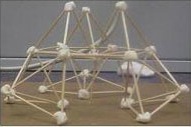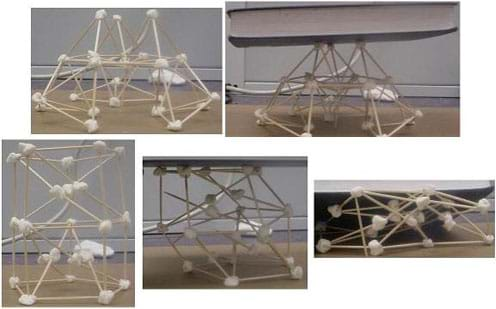Activity: Leaning Tower of Pasta
 (Activity courtesty of Teachengineering.org) Grade Level: 6 (5-7) Group Size: 2. Time Required: 45 minutes. Expendable Cost Per Group: US $1
(Activity courtesty of Teachengineering.org) Grade Level: 6 (5-7) Group Size: 2. Time Required: 45 minutes. Expendable Cost Per Group: US $1
Summary
Using spaghetti and marshmallows, students in grades 5 – 7 experiment with different structures to determine which ones are able to handle the greatest amount of load. Their experiments help them to further understand the effects that compression and tension forces have with respect to the strength of structures. Spaghetti cannot hold much tension or compression; therefore, it breaks very easily. Marshmallows handle compression well, but do not hold up to tension.
Engineering Connection
Engineers consider tension and compression forces when designing a building or structure, and choosing the materials to build it. All structures must be able to handle the forces that act upon them so they will not fail and injure people, wildlife or the environment. Like all structures, the foundation, frame and joints of a skyscraper must be able to withstand enormous tension and compression forces from the weight of its own materials, the load of people and equipment it holds and the impact of natural forces such as wind, snow and earthquakes.
Learning Objectives
After this activity, students should be able to:
- Understand that compression and tension affect the stability of a structure.
- Recognize components of their structure that are experiencing tension, and other components that are experiencing compression.
- Suggest materials that would make their structure stronger.
- Use number sense to correlate the strength of a structure to the amount of weight it holds.
- Identify shapes that are better at supporting loads.
- Understand that geometry is a significant factor in the amount of weight a building can support.
- Compare their model to others to understand why some models are stronger than others.
- Collect data by measuring the height of their structure and how much weight it can hold.
- Use different building models to predict how much weight a building can hold.
Standards
Colorado Math. Grade 8, 2009
- Compare and order sets of integers and rational numbers that are expressed as fractions, decimals, or percents
- Add, subtract, multiply and divide rational numbers including integers, positive and negative fractions and decimals
Colorado Science. Grades 6 – 8, 2000
- Predict and evaluate the movement of an object by examining the forces applied to it
- Identify the distinguishing characteristics between a chemical and a physical change
International Technology Education Association-ITEA STL Standards Technology. Grades 6 – 8, 2000
- Make two-dimensional and three-dimensional representations of the designed solution
- Structures rest on a foundation.
Vocabulary
Keywords: mechanics, tension, compression, structures, tensile, forces, sky scraper
Materials
Per group:
- Standing Strong Worksheet
- 20 unbroken pieces of uncooked, long pasta, such as spaghetti, linguine or fettuccini
- 30 small marshmallows
- Measuring tape or ruler
- Weights or small books
Background
Have you ever wondered how really tall buildings stay up? Why do sky scrapers not fall down when wind hits them? Engineers work with architects and scientists to understand what makes materials break, and then use what they learn to design strong structures. Today, you will have the opportunity to figure out how to make a strong structure, too. Sometimes, engineers may be able to find very strong materials, but they cannot use them in a structure because the material are too expensive. Sometimes, engineers cannot use as much material as they might like due to budget or supply limitations. Just like an engineer, today you will be constrained; you can only use a limited amount of materials. Your job is to design and build a structure that is as tall and strong as possible, using only marshmallows and spaghetti.
As you build, think about what forces will be acting upon your structure. Which parts will be pushed together, that is, which will experience compression and which parts will be pulled apart , that is, which will be under tension. Is it better to have a piece of spaghetti or a marshmallow under tension? Under compression? How will you design the tallest, strongest structure using limited resources?
Procedure
Safety: The rigid, long pasta could injure an eye. Although this is an activity with a lot of freedom, students should not horseplay with the spaghetti.
Before the Activity
1. Introduce the activity with a discussion, being sure to solicit, integrate and summarize student responses. Have you ever built a tower? What did you use for the material(s)? How strong was it? How did you know it was/was not strong?
2. As a class, examine these pictures below, noting which structures are strong and which are not.
3. Before they start construction, make sure students understand where you will add weight to their structure to test it. Knowing this should be a consideration in their structure design. For example, it is difficult to add weight to a tall, narrow tower.
4. Distribute a Standing Strong Worksheet for each group, directing them to fill the sheets out during and after their construction.
 |
Image credit: Ben Heavner, ITL Program and Laboratory, University of Colorado at Boulder, 2004.
Activity:
The object of this activity is for the students to build a tower as high AND as strong as they can using only a limited supply of spaghetti (or linguine or fettuccini) and marshmallows. There are no step-by-step instructions for this project, only the constraints of limited resources. Students can do whatever they want with the materials to try to build a structure as tall, stable and strong as possible. The project can be made more difficult by adding more constraints such as fewer materials, a minimum height requirement, or a requirement to support at least a minimum weight for a given time. Let the student teams’ imagination, creativity and ingenuity run wild.
Worksheet: Have the students complete the activity worksheet; review their answers to gauge their mastery of the subject. After student teams finish their worksheets, have them compare answers with a peer group, giving all students time to finish the worksheet.
Competition:
Hold a competition and give points for how tall the structure is as well as how much weight it can hold. A good way to comparatively measure the effectiveness of each structure is by having students take the load the structure can support and divide it by the weight of the structure. The higher this number, the more effective the structure. For example, 30g (maximum weight structure could hold) divided by 10g (weight of structure alone) = 3.
Before testing the structures, have students measure and record the height and weight of their structure.
How much weight does the structure support? Five grams? 10 grams? 20 grams? 30 grams? Have students record their structure’s maximum weight held on the worksheet, and calculate the load to weight ratio for comparison purposes.
Assessment
Discussion:
- Discuss which structure was the tallest and held the most weight. Which structures had the highest ratio of load to structure weight? Which structures held the most weight, regardless of height, and why.
- Discuss the success or failure of the materials used. Spaghetti cannot hold much tension or compression; therefore, it breaks very easily. Marshmallows handle compression well, but do not hold up to tension (the spaghetti can slip out of them).
- Ask which geometric shapes seemed the strongest for holding weight — triangles, squares, or circles
Worksheet:
Have students complete the activity worksheet; review their answers to gauge their mastery of the subject. Pairs Check: After student teams finish their worksheets, have them compare answers with a peer group, giving all students time to finish the worksheet.
Class Presentations:
Have the student groups take turns presenting the structures to the rest of the class. Ask them to explain where the forces tension and compression are taking place. Have the class determine which shapes seem to be the strongest for holding up weight.
Toss-a-Question:
Using questions 1-7 on the Standing Strong Worksheet, have students work in groups and toss a ball (or wad of paper) back and forth. The student with the ball asks a question and then tosses the ball to someone to answer. If a student does not know the answer, s/he tosses the ball onward until someone gets it. The person who gets the answer correct gets to start the next question. Review the answers at the end and have the students write down the correct answers on their worksheets.
Extensions
- Have the students build models using materials other than marshmallows and pasta, such as toothpicks, gumdrops, caramels, Popsicle sticks, etc. Which materials made even better buildings than spaghetti and marshmallows, and why? Have the students discuss these materials in terms of compression and tension.
- Have the students design their own experiment to look at the geometry behind different structures. Which shape can hold the most weight — a triangle, square or circle? Challenge the students to explain their answers by creating diagrams showing the compression and tension forces on each shape.
Credit: Integrated Teaching and Learning Program, College of Engineering, University of Colorado at Boulder. Contributors: Chris Yakacki, Ben Heavner, Malinda Schaefer Zarske, Denise Carlson. Copyright: 2004 by Regents of the University of Colorado.
Resources
See other eGFI building activities and lessons:
Filed under: Class Activities, Grades 6-8
Tags: Building Design, Civil Engineering, Team-building skills








